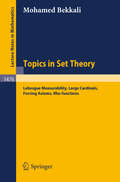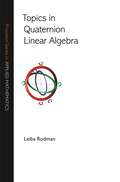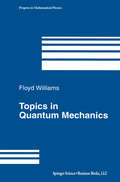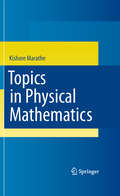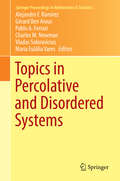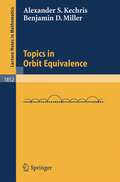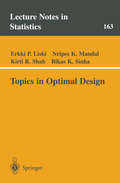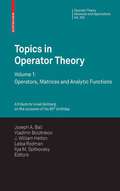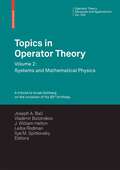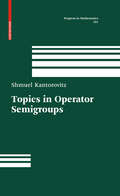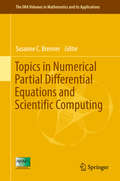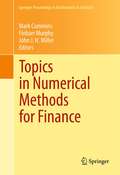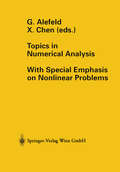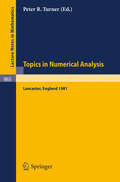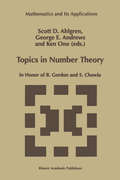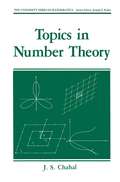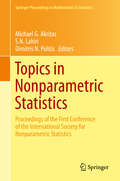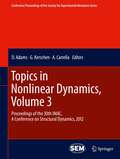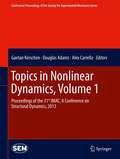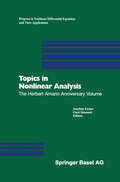- Table View
- List View
Topics in Set Theory: Lebesgue Measurability, Large Cardinals, Forcing Axioms, Rho-functions (Lecture Notes in Mathematics #1476)
by Mohamed BekkaliDuring the Fall Semester of 1987, Stevo Todorcevic gave a series of lectures at the University of Colorado. These notes of the course, taken by the author, give a novel and fast exposition of four chapters of Set Theory. The first two chapters are about the connection between large cardinals and Lebesque measure. The third is on forcing axioms such as Martin's axiom or the Proper Forcing Axiom. The fourth chapter looks at the method of minimal walks and p-functions and their applications. The book is addressed to researchers and graduate students interested in Set Theory, Set-Theoretic Topology and Measure Theory.
Topics in Quaternion Linear Algebra
by Leiba RodmanQuaternions are a number system that has become increasingly useful for representing the rotations of objects in three-dimensional space and has important applications in theoretical and applied mathematics, physics, computer science, and engineering. This is the first book to provide a systematic, accessible, and self-contained exposition of quaternion linear algebra. It features previously unpublished research results with complete proofs and many open problems at various levels, as well as more than 200 exercises to facilitate use by students and instructors. Applications presented in the book include numerical ranges, invariant semidefinite subspaces, differential equations with symmetries, and matrix equations.Designed for researchers and students across a variety of disciplines, the book can be read by anyone with a background in linear algebra, rudimentary complex analysis, and some multivariable calculus. Instructors will find it useful as a complementary text for undergraduate linear algebra courses or as a basis for a graduate course in linear algebra. The open problems can serve as research projects for undergraduates, topics for graduate students, or problems to be tackled by professional research mathematicians. The book is also an invaluable reference tool for researchers in fields where techniques based on quaternion analysis are used.
Topics in Quaternion Linear Algebra
by Leiba RodmanQuaternions are a number system that has become increasingly useful for representing the rotations of objects in three-dimensional space and has important applications in theoretical and applied mathematics, physics, computer science, and engineering. This is the first book to provide a systematic, accessible, and self-contained exposition of quaternion linear algebra. It features previously unpublished research results with complete proofs and many open problems at various levels, as well as more than 200 exercises to facilitate use by students and instructors. Applications presented in the book include numerical ranges, invariant semidefinite subspaces, differential equations with symmetries, and matrix equations.Designed for researchers and students across a variety of disciplines, the book can be read by anyone with a background in linear algebra, rudimentary complex analysis, and some multivariable calculus. Instructors will find it useful as a complementary text for undergraduate linear algebra courses or as a basis for a graduate course in linear algebra. The open problems can serve as research projects for undergraduates, topics for graduate students, or problems to be tackled by professional research mathematicians. The book is also an invaluable reference tool for researchers in fields where techniques based on quaternion analysis are used.
Topics in Quantum Mechanics (Progress in Mathematical Physics #27)
by Floyd WilliamsThis self-contained text presents quantum mechanics from the point of view of some computational examples with a mixture of mathematical clarity often not found in texts offering only a purely physical point of view. Emphasis is placed on the systematic application of the Nikiforov-- Uvarov theory of generalized hypergeometric differential equations to solve the Schr"dinger equation and to obtain the quantization of energies from a single unified point of view.
Topics in Physical Mathematics
by Kishore MaratheAs many readers will know, the 20th century was a time when the fields of mathematics and the sciences were seen as two separate entities. Caused by the rapid growth of the physical sciences and an increasing abstraction in mathematical research, each party, physicists and mathematicians alike, suffered a misconception; not only of the opposition’s theoretical underpinning, but of how the two subjects could be intertwined and effectively utilized. One sub-discipline that played a part in the union of the two subjects is Theoretical Physics. Breaking it down further came the fundamental theories, Relativity and Quantum theory, and later on Yang-Mills theory. Other areas to emerge in this area are those derived from the works of Donaldson, Chern-Simons, Floer-Fukaya, and Seiberg-Witten. Aimed at a wide audience, Physical Topics in Mathematics demonstrates how various physical theories have played a crucial role in the developments of Mathematics and in particular, Geometric Topology. Issues are studied in great detail, and the book steadfastly covers the background of both Mathematics and Theoretical Physics in an effort to bring the reader to a deeper understanding of their interaction. Whilst the world of Theoretical Physics and Mathematics is boundless; it is not the intention of this book to cover its enormity. Instead, it seeks to lead the reader through the world of Physical Mathematics; leaving them with a choice of which realm they wish to visit next.
Topics in Percolative and Disordered Systems (Springer Proceedings in Mathematics & Statistics #69)
by Alejandro F. Ramírez Gérard Ben Arous Pablo A. Ferrari Charles M. Newman Vladas Sidoravicius Maria Eulália VaresThis volume features selected and peer-reviewed articles from the Pan-American Advanced Studies Institute (PASI). The chapters are written by international specialists who participated in the conference. Topics include developments based on breakthroughs in the mathematical understanding of phenomena describing systems in highly inhomogeneous and disordered media, including the KPZ universality class (describing the evolution of interfaces in two dimensions), random walks in random environment and percolative systems. PASI fosters a collaboration between North American and Latin American researchers and students. The conference that inspired this volume took place in January 2012 in both Santiago de Chile and Buenos Aires. Researchers and graduate students will find timely research in probability theory, statistical physics and related disciplines.
Topics in Orbit Equivalence (Lecture Notes in Mathematics #1852)
by Alexander Kechris Benjamin D. MillerThis volume provides a self-contained introduction to some topics in orbit equivalence theory, a branch of ergodic theory. The first two chapters focus on hyperfiniteness and amenability. Included here are proofs of Dye's theorem that probability measure-preserving, ergodic actions of the integers are orbit equivalent and of the theorem of Connes-Feldman-Weiss identifying amenability and hyperfiniteness for non-singular equivalence relations. The presentation here is often influenced by descriptive set theory, and Borel and generic analogs of various results are discussed. The final chapter is a detailed account of Gaboriau's recent results on the theory of costs for equivalence relations and groups and its applications to proving rigidity theorems for actions of free groups.
Topics in Optimal Design (Lecture Notes in Statistics #163)
by Erkki P. Liski Nripes K. Mandal Kirti R. Shah Bikas K. SinhaThis book covers a wide range of topics in both discrete and continuous optimal designs. The topics discussed include designs for regression models, covariates models, models with trend effects, and models with competition effects. The prerequisites are a basic course in the design and analysis of experiments and some familiarity with the concepts of optimality criteria.
Topics in Operator Theory: Volume 1: Operators, Matrices and Analytic functions (Operator Theory: Advances and Applications #202)
by Joseph A. Ball Vladimir Bolotnikov J. William Helton Leiba Rodman Ilya M. SpitkovskyThis is the first volume of a collection of original and review articles on recent advances and new directions in a multifaceted and interconnected area of mathematics and its applications. It encompasses many topics in theoretical developments in operator theory and its diverse applications in applied mathematics, physics, engineering, and other disciplines. The purpose is to bring in one volume many important original results of cutting edge research as well as authoritative review of recent achievements, challenges, and future directions in the area of operator theory and its applications.
Topics in Operator Theory: Volume 2: Systems and Mathematical Physics (Operator Theory: Advances and Applications #203)
by Joseph A. Ball Vladimir Bolotnikov J. William Helton Leiba Rodman Ilya M. SpitkovskyThis is the second volume of a collection of original and review articles on recent advances and new directions in a multifaceted and interconnected area of mathematics and its applications. It encompasses many topics in theoretical developments in operator theory and its diverse applications in applied mathematics, physics, engineering, and other disciplines. The purpose is to bring in one volume many important original results of cutting edge research as well as authoritative review of recent achievements, challenges, and future directions in the area of operator theory and its applications.
Topics in Operator Semigroups (Progress in Mathematics #281)
by Shmuel KantorovitzThis monograph is concerned with the interplay between the theory of operator semigroups and spectral theory. The basics on operator semigroups are concisely covered in this self-contained text. Part I deals with the Hille--Yosida and Lumer--Phillips characterizations of semigroup generators, the Trotter--Kato approximation theorem, Kato’s unified treatment of the exponential formula and the Trotter product formula, the Hille--Phillips perturbation theorem, and Stone’s representation of unitary semigroups. Part II explores generalizations of spectral theory’s connection to operator semigroups.
Topics in Numerical Partial Differential Equations and Scientific Computing (The IMA Volumes in Mathematics and its Applications #160)
by Susanne C. BrennerNumerical partial differential equations (PDEs) are an important part of numerical simulation, the third component of the modern methodology for science and engineering, besides the traditional theory and experiment. This volume contains papers that originated with the collaborative research of the teams that participated in the IMA Workshop for Women in Applied Mathematics: Numerical Partial Differential Equations and Scientific Computing in August 2014.
Topics in Numerical Methods for Finance (Springer Proceedings in Mathematics & Statistics #19)
by Mark Cummins Finbarr Murphy John J. H. MillerPresenting state-of-the-art methods in the area, the book begins with a presentation of weak discrete time approximations of jump-diffusion stochastic differential equations for derivatives pricing and risk measurement. Using a moving least squares reconstruction, a numerical approach is then developed that allows for the construction of arbitrage-free surfaces. Free boundary problems are considered next, with particular focus on stochastic impulse control problems that arise when the cost of control includes a fixed cost, common in financial applications. The text proceeds with the development of a fear index based on equity option surfaces, allowing for the measurement of overall fear levels in the market. The problem of American option pricing is considered next, applying simulation methods combined with regression techniques and discussing convergence properties. Changing focus to integral transform methods, a variety of option pricing problems are considered. The COS method is practically applied for the pricing of options under uncertain volatility, a method developed by the authors that relies on the dynamic programming principle and Fourier cosine series expansions. Efficient approximation methods are next developed for the application of the fast Fourier transform for option pricing under multifactor affine models with stochastic volatility and jumps. Following this, fast and accurate pricing techniques are showcased for the pricing of credit derivative contracts with discrete monitoring based on the Wiener-Hopf factorisation. With an energy theme, a recombining pentanomial lattice is developed for the pricing of gas swing contracts under regime switching dynamics. The book concludes with a linear and nonlinear review of the arbitrage-free parity theory for the CDS and bond markets.
Topics in Numerical Analysis: With Special Emphasis on Nonlinear Problems (Computing Supplementa #15)
by G. Alefeld Xiaojun ChenThis volume contains eighteen papers submitted in celebration of the sixty-fifth birthday of Professor Tetsuro Yamamoto of Ehime University. Professor Yamamoto was born in Tottori, Japan on January 4, 1937. He obtained his B. S. and M. S. in mathematics from Hiroshima University in 1959 and 1961, respec tively. In 1966, he took a lecturer position in the Department of Mathematics, Faculty of General Education, Hiroshima University and obtained his Ph. D. degree from Hiroshima University two years later. In 1969, he moved to the Department of Applied Mathematics, Faculty of Engineering, Ehime University as an associate professor and he has been a full professor of the Department of Mathematics (now Department of Mathematical Sciences), Faculty of Science, since 1975. At the early stage of his study, he was interested in algebraic eigen value problems and linear iterative methods. He published some papers on these topics in high level international journals. After moving to Ehime University, he started his research on Newton's method and Newton-like methods for nonlinear operator equations. He published many papers on error estimates of the methods. He established the remarkable result that all the known error bounds for Newton's method under the Kantorovich assumptions follow from the Newton-Kantorovich theorem, which put a period to the race of finding sharper error bounds for Newton's method.
Topics in Numerical Analysis: Proceedings of the S.E.R.C. Summer School, Lancaster, July 19 - August 21, 1981 (Lecture Notes in Mathematics #965)
by P. R. TurnerTopics in Number Theory: In Honor of B. Gordon and S. Chowla (Mathematics and Its Applications #467)
by Scott D. Ahlgren George E. Andrews Ken OnoFrom July 31 through August 3,1997, the Pennsylvania State University hosted the Topics in Number Theory Conference. The conference was organized by Ken Ono and myself. By writing the preface, I am afforded the opportunity to express my gratitude to Ken for beng the inspiring and driving force behind the whole conference. Without his energy, enthusiasm and skill the entire event would never have occurred. We are extremely grateful to the sponsors of the conference: The National Sci ence Foundation, The Penn State Conference Center and the Penn State Depart ment of Mathematics. The object in this conference was to provide a variety of presentations giving a current picture of recent, significant work in number theory. There were eight plenary lectures: H. Darmon (McGill University), "Non-vanishing of L-functions and their derivatives modulo p. " A. Granville (University of Georgia), "Mean values of multiplicative functions. " C. Pomerance (University of Georgia), "Recent results in primality testing. " C. Skinner (Princeton University), "Deformations of Galois representations. " R. Stanley (Massachusetts Institute of Technology), "Some interesting hyperplane arrangements. " F. Rodriguez Villegas (Princeton University), "Modular Mahler measures. " T. Wooley (University of Michigan), "Diophantine problems in many variables: The role of additive number theory. " D. Zeilberger (Temple University), "Reverse engineering in combinatorics and number theory. " The papers in this volume provide an accurate picture of many of the topics presented at the conference including contributions from four of the plenary lectures.
Topics in Number Theory (University Series in Mathematics)
by J.S. ChahalThis book reproduces, with minor changes, the notes prepared for a course given at Brigham Young University during the academic year 1984-1985. It is intended to be an introduction to the theory of numbers. The audience consisted largely of undergraduate students with no more background than high school mathematics. The presentation was thus kept as elementary and self-contained as possible. However, because the discussion was, generally, carried far enough to introduce the audience to some areas of current research, the book should also be useful to graduate students. The only prerequisite to reading the book is an interest in and aptitude for mathe matics. Though the topics may seem unrelated, the study of diophantine equations has been our main goal. I am indebted to several mathematicians whose published as well as unpublished work has been freely used throughout this book. In particular, the Phillips Lectures at Haverford College given by Professor John T. Tate have been an important source of material for the book. Some parts of Chapter 5 on algebraic curves are, for example, based on these lectures.
Topics in Nonparametric Statistics: Proceedings of the First Conference of the International Society for Nonparametric Statistics (Springer Proceedings in Mathematics & Statistics #74)
by Michael G. Akritas S. N. Lahiri Dimitris N. PolitisThis volume is composed of peer-reviewed papers that have developed from the First Conference of the International Society for Non Parametric Statistics (ISNPS). This inaugural conference took place in Chalkidiki, Greece, June 15-19, 2012. It was organized with the co-sponsorship of the IMS, the ISI and other organizations. M.G. Akritas, S.N. Lahiri and D.N. Politis are the first executive committee members of ISNPS and the editors of this volume. ISNPS has a distinguished Advisory Committee that includes Professors R.Beran, P.Bickel, R. Carroll, D. Cook, P. Hall, R. Johnson, B. Lindsay, E. Parzen, P. Robinson, M. Rosenblatt, G. Roussas, T. SubbaRao and G. Wahba. The Charting Committee of ISNPS consists of more than 50 prominent researchers from all over the world.The chapters in this volume bring forth recent advances and trends in several areas of nonparametric statistics. In this way, the volume facilitates the exchange of research ideas, promotes collaboration among researchers from all over the world and contributes to the further development of the field. The conference program included over 250 talks, including special invited talks, plenary talks and contributed talks on all areas of nonparametric statistics. Out of these talks, some of the most pertinent ones have been refereed and developed into chapters that share both research and developments in the field.
Topics in Nonlinear Dynamics, Volume 3: Proceedings of the 30th IMAC, A Conference on Structural Dynamics, 2012 (Conference Proceedings of the Society for Experimental Mechanics Series #28)
by D. Adams, G. Kerschen and A. CarrellaTopics in Nonlinear Dynamics, Volume 3, Proceedings of the 30th IMAC, A Conference and Exposition on Structural Dynamics, 2012, the third volume of six from the Conference, brings together 26 contributions to this important area of research and engineering. The collection presents early findings and case studies on fundamental and applied aspects of Structural Dynamics, including papers on: Application of Nonlinearities: Aerospace Structures Nonlinear Dynamics Effects Under Shock Loading Application of Nonlinearities: Vibration Reduction Nonlinear Dynamics: Testing Nonlinear Dynamics: Simulation Nonlinear Dynamics: Identification Nonlinear Dynamics: Localization
Topics in Nonlinear Dynamics, Volume 1: Proceedings of the 31st IMAC, A Conference on Structural Dynamics, 2013 (Conference Proceedings of the Society for Experimental Mechanics Series #35)
by Gaetan Kerschen, Douglas Adams and Alex CarrellaTopics in Nonlinear Dynamics, Volume 1: Proceedings of the 31st IMAC, A Conference and Exposition on Structural Dynamics, 2013, the first volume of seven from the Conference, brings together contributions to this important area of research and engineering. The collection presents early findings and case studies on fundamental and applied aspects of Structural Dynamics, including papers on: Nonlinear OscillationsNonlinearities … In PracticeNonlinear System Identification: MethodsNonlinear System Identification: Friction & ContactNonlinear Modal AnalysisNonlinear Modeling & SimulationNonlinear Vibration AbsorbersConstructive Utilization of Nonlinearity
Topics in Nonlinear Analysis: The Herbert Amann Anniversary Volume (Progress in Nonlinear Differential Equations and Their Applications #35)
by Joachim Escher Gieri SimonettTopics in Nonconvex Optimization: Theory and Applications (Nonconvex Optimization and Its Applications #50)
by Shashi K. MishraNonconvex Optimization is a multi-disciplinary research field that deals with the characterization and computation of local/global minima/maxima of nonlinear, nonconvex, nonsmooth, discrete and continuous functions. Nonconvex optimization problems are frequently encountered in modeling real world systems for a very broad range of applications including engineering, mathematical economics, management science, financial engineering, and social science.This contributed volume consists of selected contributions from the Advanced Training Programme on Nonconvex Optimization and Its Applications held at Banaras Hindu University in March 2009. It aims to bring together new concepts, theoretical developments, and applications from these researchers. Both theoretical and applied articles are contained in this volume which adds to the state of the art research in this field. Topics in Nonconvex Optimization is suitable for advanced graduate students and researchers in this area.
Topics in Noncommutative Algebra: The Theorem of Campbell, Baker, Hausdorff and Dynkin (Lecture Notes in Mathematics #2034)
by Andrea Bonfiglioli Roberta FulciMotivated by the importance of the Campbell, Baker, Hausdorff, Dynkin Theorem in many different branches of Mathematics and Physics (Lie group-Lie algebra theory, linear PDEs, Quantum and Statistical Mechanics, Numerical Analysis, Theoretical Physics, Control Theory, sub-Riemannian Geometry), this monograph is intended to: fully enable readers (graduates or specialists, mathematicians, physicists or applied scientists, acquainted with Algebra or not) to understand and apply the statements and numerous corollaries of the main result, provide a wide spectrum of proofs from the modern literature, comparing different techniques and furnishing a unifying point of view and notation, provide a thorough historical background of the results, together with unknown facts about the effective early contributions by Schur, Poincaré, Pascal, Campbell, Baker, Hausdorff and Dynkin, give an outlook on the applications, especially in Differential Geometry (Lie group theory) and Analysis (PDEs of subelliptic type) and quickly enable the reader, through a description of the state-of-art and open problems, to understand the modern literature concerning a theorem which, though having its roots in the beginning of the 20th century, has not ceased to provide new problems and applications.The book assumes some undergraduate-level knowledge of algebra and analysis, but apart from that is self-contained. Part II of the monograph is devoted to the proofs of the algebraic background. The monograph may therefore provide a tool for beginners in Algebra.
Topics in Non-Commutative Geometry
by Y. ManinThere is a well-known correspondence between the objects of algebra and geometry: a space gives rise to a function algebra; a vector bundle over the space corresponds to a projective module over this algebra; cohomology can be read off the de Rham complex; and so on. In this book Yuri Manin addresses a variety of instances in which the application of commutative algebra cannot be used to describe geometric objects, emphasizing the recent upsurge of activity in studying noncommutative rings as if they were function rings on "noncommutative spaces." Manin begins by summarizing and giving examples of some of the ideas that led to the new concepts of noncommutative geometry, such as Connes' noncommutative de Rham complex, supergeometry, and quantum groups. He then discusses supersymmetric algebraic curves that arose in connection with superstring theory; examines superhomogeneous spaces, their Schubert cells, and superanalogues of Weyl groups; and provides an introduction to quantum groups. This book is intended for mathematicians and physicists with some background in Lie groups and complex geometry.Originally published in 1991.The Princeton Legacy Library uses the latest print-on-demand technology to again make available previously out-of-print books from the distinguished backlist of Princeton University Press. These editions preserve the original texts of these important books while presenting them in durable paperback and hardcover editions. The goal of the Princeton Legacy Library is to vastly increase access to the rich scholarly heritage found in the thousands of books published by Princeton University Press since its founding in 1905.
Topics in Nevanlinna Theory (Lecture Notes in Mathematics #1433)
by Serge Lang William CherryThese are notes of lectures on Nevanlinna theory, in the classical case of meromorphic functions, and the generalization by Carlson-Griffith to equidimensional holomorphic maps using as domain space finite coverings of C resp. Cn. Conjecturally best possible error terms are obtained following a method of Ahlfors and Wong. This is especially significant when obtaining uniformity for the error term w.r.t. coverings, since the analytic yields case a strong version of Vojta's conjectures in the number-theoretic case involving the theory of heights. The counting function for the ramified locus in the analytic case is the analogue of the normalized logarithmetic discriminant in the number-theoretic case, and is seen to occur with the expected coefficient 1. The error terms are given involving an approximating function (type function) similar to the probabilistic type function of Khitchine in number theory. The leisurely exposition allows readers with no background in Nevanlinna Theory to approach some of the basic remaining problems around the error term. It may be used as a continuation of a graduate course in complex analysis, also leading into complex differential geometry.
